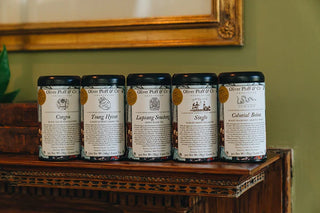Dear Oliver,
I have recently been looking for a jar to store my loose tea and found out
that a dark environment is essential to limit the unwanted oxidation process
of my tea. That said, using clear glass containers or clear bags pose a
problem unless they are stored in darkened drawers or cabinets.
Tins seem to be the method of choice for most teas because they are dark
and limit the amount of air circulating around the tea. Ceramic canisters
work, but a tight-fitting lid is recommended. Tea drinkers should avoid
plastic because it can absorb or transfer odors and flavors.
Oliver, it is helpful that many of your teas arrive in decorated refillable
canisters, which work well and look nice on display as well. And, in my
search I found your 16-ounce black tea tin that I can use for your loose-leaf
teas.

According to MarthaStewart, “the three enemies of tea are sunlight,
moisture, and temperature.”
In addition to light, tea should not be stored in your spice cabinet or with
coffees. Those strong odors can change your tea profile as well. Only a few
teas need a cooler environment such as the refrigerator. “Japanese green
teas such as sencha, gyokuro, and matcha are quite tender and best kept
in the refrigerator-in a sealed container to prevent them from absorbing
other flavors,” MarthaStewart.
Finally, tea leaves are hydroscopic, which means they pull moisture in from
the air. Keeping them airtight will preserve freshness and limit flavor
degradation. Of course, there are experts that aim to achieve the perfect
humidity for storing tea, according to teaguardian.
“A properly processed tea has a moisture level between 3 to 6%. It is a
powerful absorption agent. You can basically use it as a deodourizer or a
dehumidifier in the fridge or shoe cabinet. That is exactly why tea has to be
kept in a very airtight container.
One thing that oxygen in the air does to the tea is to oxidize its many tasteful, aromatic and salutary ingredients. Here is an example: when a fine green tea such as Longjing is stored in a light- tight, but not air-tight container, it gradually turns reddish and tastes very poorly. Thearubigen and theabrownins are formed giving that reddish colour, out of oxidation of the tea’s original richly stored polyphenols.”

So, to maximize enjoyment, I will order my tea tins and keep them in my
dark cabinets with my ceramic mugs and keep the coffee and spices away!

